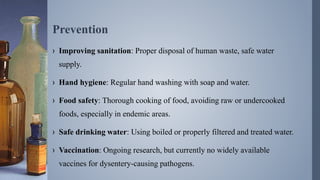What is Dysentery?

Dysentery is an infectious disease caused by the bacteria Shigella, Salmonella, or the parasite Entamoeba histolytica. The bacteria or parasite can contaminate food, water, or soil, and can be spread through the feces of infected individuals, contaminated food and water, or through direct contact with an infected person. The incubation period of dysentery is typically 1-3 days, after which symptoms such as diarrhea, abdominal pain, fever, and vomiting may occur.
Causes of Dysentery
Dysentery is caused by a range of factors, including:
- Poor Sanitation and Hygiene: Inadequate waste disposal, lack of access to clean water, and poor personal hygiene practices contribute to the spread of dysentery.
- Contaminated Food and Water: Food and water contaminated with the bacteria or parasite can cause dysentery.
- Direct Contact: Direct contact with an infected person, such as through touching or sharing food and utensils, can spread the disease.
- Poor Food Handling and Preparation: Inadequate food handling and preparation practices, such as not washing hands before handling food, can lead to the spread of dysentery.
Symptoms of Dysentery
The symptoms of dysentery can range from mild to severe and may include:
- Diarrhea: Frequent, loose, and watery stools, often with blood and mucus.
- Abdominal Pain: Severe abdominal pain, cramping, and tenderness.
- Fever: High fever, often above 101°F (38.3°C).
- Vomiting: Frequent vomiting, which can lead to dehydration.
- Dehydration: Severe dehydration, which can lead to electrolyte imbalances and other complications.
Prevention of Dysentery
Preventing dysentery requires a multi-faceted approach that involves individual, community, and governmental efforts. Some strategies for preventing dysentery include:
- Improved Sanitation and Hygiene: Ensuring access to clean water, proper waste disposal, and promoting good personal hygiene practices, such as washing hands regularly, can help prevent the spread of dysentery.
- Safe Food and Water: Ensuring that food and water are safe to consume, through proper handling, storage, and preparation, can help prevent the spread of dysentery.
- Vaccination: Vaccines are available for some types of dysentery, such as Shigella, and can provide protection against the disease.
- Community Education: Educating communities about the causes, symptoms, and prevention of dysentery can help promote good hygiene practices and prevent the spread of the disease.
- Governmental Efforts: Governments can play a crucial role in preventing dysentery by implementing policies and programs that promote good sanitation and hygiene practices, provide access to clean water and healthcare, and promote community education and awareness.
Personal Protective Measures
Individuals can take several personal protective measures to prevent the spread of dysentery, including:
- Washing Hands: Washing hands regularly, especially after using the bathroom, before eating, and after handling food, can help prevent the spread of dysentery.
- Using Safe Water: Using safe water for drinking, cooking, and personal hygiene can help prevent the spread of dysentery.
- Avoiding Contaminated Food: Avoiding contaminated food, such as raw or undercooked meat, poultry, or seafood, can help prevent the spread of dysentery.
- Practicing Good Hygiene: Practicing good hygiene, such as washing hands regularly, covering the mouth and nose when coughing or sneezing, and avoiding close contact with individuals who are sick, can help prevent the spread of dysentery.
Community-Based Initiatives
Community-based initiatives can play a crucial role in preventing the spread of dysentery, including:
- Community Education: Educating communities about the causes, symptoms, and prevention of dysentery can help promote good hygiene practices and prevent the spread of the disease.
- Water, Sanitation, and Hygiene (WASH) Programs: Implementing WASH programs, such as providing access to clean water, improving sanitation facilities, and promoting good hygiene practices, can help prevent the spread of dysentery.
- Food Safety Initiatives: Implementing food safety initiatives, such as promoting proper food handling and preparation practices, can help prevent the spread of dysentery.
- Disease Surveillance: Establishing disease surveillance systems can help detect outbreaks of dysentery and enable rapid response and control measures.
FAQs
- What is the most effective way to prevent dysentery?
The most effective way to prevent dysentery is to practice good hygiene, such as washing hands regularly, using safe water, and avoiding contaminated food. - How can I protect myself from dysentery when traveling to endemic areas?
When traveling to endemic areas, it is essential to take personal protective measures, such as washing hands regularly, using safe water, and avoiding contaminated food. - What are the symptoms of dysentery?
The symptoms of dysentery can range from mild to severe and may include diarrhea, abdominal pain, fever, vomiting, and dehydration. - How can I treat dysentery?
Dysentery can be treated with antibiotics, such as ciprofloxacin or azithromycin, and supportive care, such as fluid replacement and rest. - Can dysentery be prevented through vaccination?
Vaccines are available for some types of dysentery, such as Shigella, and can provide protection against the disease.
Conclusion
Dysentery is a significant public health concern in many parts of the world, particularly in areas with poor sanitation and hygiene. Preventing dysentery requires a multi-faceted approach that involves individual, community, and governmental efforts. By practicing good hygiene, using safe water, avoiding contaminated food, and promoting community education and awareness, individuals can help prevent the spread of dysentery. Additionally, community-based initiatives, such as WASH programs, food safety initiatives, and disease surveillance, can play a crucial role in preventing the spread of dysentery. By working together, we can reduce the burden of dysentery and improve public health outcomes in endemic areas.
Closure
Thus, we hope this article has provided valuable insights into Dysentery prevention in endemic areas. We appreciate your attention to our article. See you in our next article!